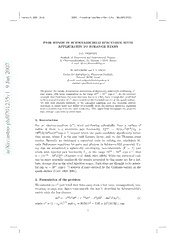
Pair Winds in Schwarzschild Spacetime with Application to Strange Stars PDF
Preview Pair Winds in Schwarzschild Spacetime with Application to Strange Stars
February5,2008 15:22 WSPC-ProceedingsTrimSize:9.75inx6.5in MS.AMU.MG11 PAIR WINDS IN SCHWARZSCHILD SPACETIME WITH APPLICATION TO STRANGE STARS A.G.AKSENOV Institute of Theoretical and Experimental Physics, B. Cheremushkinskaya, 25, Moscow 117218, Russia 7 E-mail: [email protected] 0 0 M.MILGROMandV.V.USOV 2 Centerfor Astrophysics, Weizmann Institute, n Rehovot 76100, Israel a E-mail: [email protected] J [email protected] 9 Wepresenttheresultsofnumericalsimulationsofstationary,sphericallyoutflowing,e± 1 pair winds, with total luminosities in the range 1034−1042 ergs s−1. In the concrete v exampledescribedhere,thewindinjectionsourceisahot,bare,strangestar,predicted 5 tobeapowerfulsourceofe±pairscreatedbytheCoulombbarrieratthequarksurface. 3 We find that photons dominate in the emerging emission, and the emerging photon 2 spectrum is rather hard and differs substantially from the thermal spectrum expected 1 fromaneutronstarwiththesameluminosity.Thismighthelpdistinguishtheputative 0 barestrangestarsfromneutronstars. 7 0 / h 1. Introduction p For an electron-positron (e±) wind out-flowing spherically from a surface of - o radius R there is a maximum pair luminosity, Lm±ax = 4πmec3RΓ2/σT ≃ r t 1036(R/106cm)Γ2ergs s−1, beyond which the pairs annihilate significantly before s a they escape, where Γ is the pair bulk Lorentz factor, and σT the Thomson cross v: section. Recently we developed a numerical code for solving the relativistic ki- i netic Boltzmann equations for pairs and photons in Schwarzschild geometry. Us- X ing this we considered a spherically out-flowing, non-relativistic (Γ ∼ 1) pair r a winds with injected pair luminosity L˜± in the range 1034 − 1042 ergs s−1, that is ∼(10−2−106)Lmax (Aksenov et al.2003,2004,2005).While our numericalcode ± can be more generally employed, the results presented in this paper are for a hot, bare,strangestarasthe wind injectionsource.Suchstarsarethoughtto be power- ful (up to ∼ 1051 ergs s−1) sources of pairs created by the Coulomb barrier at the quark surface (Usov 1998, 2001). 2. Formulation of the problem We considerane± pair wind that flowsawayfroma hot,bare,unmagnetized,non- rotating, strange star. Space-time outside the star is described by Schwarzschild’s metric with the line element ds2 =−e2φc2dt2+e−2φdr2+r2(dϑ2+sin2ϑdϕ2), (1) where eφ =(1−rg/r)1/2 and rg =2GM/c2 ≃2.95×105(M/M⊙) cm. 1 February5,2008 15:22 WSPC-ProceedingsTrimSize:9.75inx6.5in MS.AMU.MG11 2 We use the general relativistic Boltzmann equations for the pairs and photons, whereby the distribution function for the particles of type i, f (p,µ,r,t), satisfies i e−φ∂f 1 ∂ eφ ∂ φ′ i + (r2µeφβ f )− p3µ f c ∂t r2∂r i i p2∂p(cid:18) β i(cid:19) i ∂ φ′ β − (1−µ2)eφ − i f = (η¯q−χqf ). (2) ∂µ(cid:20) (cid:18)β r (cid:19) i(cid:21) i i i i Xq Here, µ is the cosine of the angle between the radius and the particle momentum p, p = |p|, β = v /c, β = 1, and v is the velocity of electrons and positrons. e e γ e Also, η¯q is the emission coefficient for the production of a particle of type i via the i physical process labelled by q, and χq is the corresponding absorption coefficient. i The processes we include are listed in the following Table. Basic Two-Body Radiative Interaction Variant Møller and Bhaba scattering Bremsstrahlung ee→ee ee↔eeγ Compton scattering Double Compton scattering γe→γe γe↔γeγ Pair annihilation Three photon annihilation e+e− →γγ e+e− ↔γγγ Photon-photon pair production γγ →e+e− 3. Numerical results ForinjectedpairluminosityL˜± higherthan∼1034 ergss−1,the emergingemission consists mostly ofphotons (see Fig. 1,left panel).This simply reflects the fact that inthis casethepairannihilationtimetann ∼(neσTc)−1 islessthantheescapetime tesc ∼R/c. There is an upper limit to the rate of emerging pairs N˙emax ≃1043 s−1 (see Fig. 1, right panel). As L˜± increases from ∼ 1034 to 1042 ergs s−1, the mean energy of emergent photons decreases from ∼ 400 keV to 40 keV, as the spectrum changes in shape from that of a wide annihilation line to nearly a blackbody spectrum with a high energy (>100 keV) tail (see Fig.2). February5,2008 15:22 WSPC-ProceedingsTrimSize:9.75inx6.5in MS.AMU.MG11 3 100 1043 -1 10 42 -2 10 L 10 -1 s ] L / i 10-3 e– . N [– 41 10 -4 10 40 -5 10 10 34 35 36 37 38 39 40 41 42 34 35 36 37 38 39 40 41 42 10 10 10 10 10 10 10 10 10 10 10 10 10 10 10 10 10 10 ~ -1 ~ -1 L – [ergs s ] L – [ergs s ] Fig. 1. LEFT: The fractional emerging luminosities in pairs (dashed line) and photons (solid line)as functions of the injectedpair luminosity,L˜±. RIGHT: Numberrate ofemergingpairs as functions of L˜± (solid line). The case where gravity has been neglected is shown by the dashed line. 40 500 -1-1 s keV s] 1111000033336789 101309401041 1042 V ] 400 2b g 10 e 300 [er 1035 1038 > [ k dL / d 11003334 1037 <i 200 e 1032 1036 31 35 100 10 10 1030 1034 bb 29 0 10 34 35 36 37 38 39 40 41 42 20 100 500 10 10 10 10 10 10 10 10 10 ~ -1 [ keV ] L – [ergs s ] Fig. 2. LEFT: The energy spectrum of emerging photons for different values of L˜±, as marked onthecurves.Thedashedlineisthespectrumofblackbodyemission.RIGHT:Themeanenergy of the emerging photons (thick solid line) and electrons (thin solid line) as a function of L˜±. For comparison, we show as the dotted linethe mean energy of blackbody photons for the same energy density as that of the photons at the photosphere. Also shown as the dashed line is the meanenergyoftheemergingphotons inthecasewhenonlytwoparticleprocessesaretakeninto account. Acknowledgments TheresearchwassupportedbytheIsraelScienceFoundationoftheIsraelAcademy of Sciences and Humanities. References 1. A.G. Aksenov,M. Milgrom and V.V.Usov, Mon. Not. RAS343, L69 (2003). 2. A.G. Aksenov,M. Milgrom and V.V.Usov, Astrophys. J. 609, 363 (2004). 3. A.G. Aksenov,M. Milgrom and V.V.Usov, Astrophys. J. 623, 567 (2005). 4. V.V.Usov, Phys. Rev. Lett. 80, 230 (1998). 5. V.V.Usov, Astrophys. J. Lett. 550, L179 (2001).
